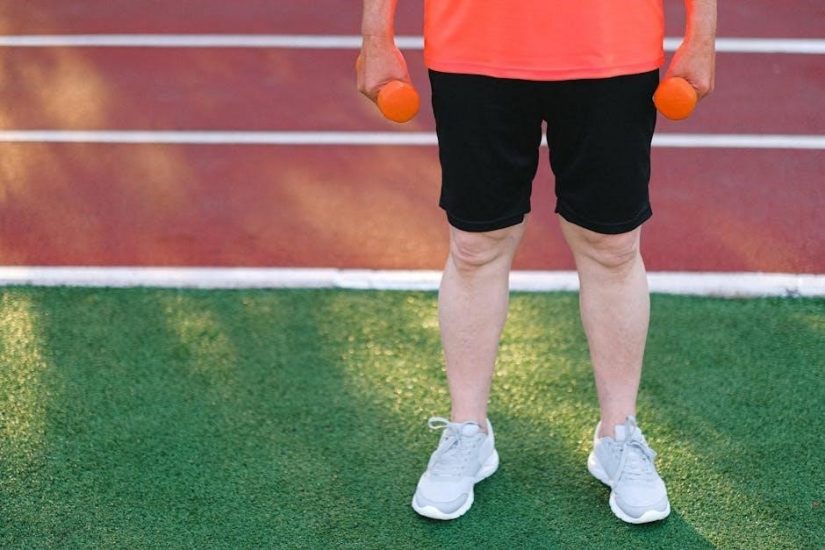Gross Motor Skills Development
Gross motor skills development for 3-5 year olds includes activities like jumping‚ running‚ and climbing. These exercises enhance coordination‚ balance‚ and overall physical fitness in young children.
- Jumping over obstacles improves coordination.
- Running games boost endurance and leg strength.
- Climbing structures develop upper body strength.
Running and Walking
Running and walking activities are essential for developing gross motor skills in 3-5 year olds. Simple games like running around cones or following a leader encourage endurance and coordination. Walking on a balance beam or along a straight line improves stability. Incorporating fun elements‚ such as music or obstacles‚ makes these activities engaging. For example‚ running to collect balls or walking while carrying small objects enhances both speed and control. These exercises not only build physical fitness but also prepare children for more complex movements like jumping and climbing in later stages.
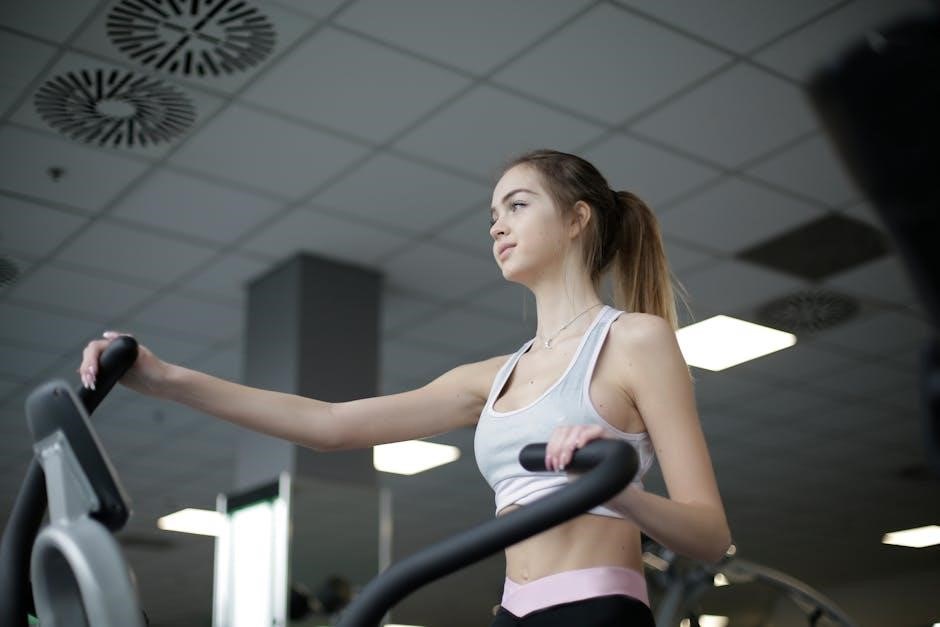
- Running around cones or markers to practice speed and direction.
- Walking on a balance beam or straight line to enhance stability.
- Playing follow-the-leader with dynamic movements to improve coordination.
Jumping and Climbing
Jumping and climbing activities are key for enhancing gross motor skills in 3-5 year olds. Jumping over cushions or puddles improves coordination and leg strength‚ while climbing soft foam blocks or low-height structures builds upper body strength and confidence. These activities also promote problem-solving and spatial awareness. For example‚ climbing onto a chair or navigating an obstacle course encourages children to explore their physical capabilities safely. Regular practice of these skills helps children master more complex movements and boosts their overall physical fitness and agility.
- Jumping over small obstacles like cushions or cones.
- Climbing soft foam blocks or low climbing frames.
- Navigating mini obstacle courses with climbing and jumping challenges.
Balance and Coordination
Balance and coordination activities for 3-5 year olds focus on refining their ability to control movements and maintain stability. Simple exercises like standing on one foot or walking along a straight line enhance balance‚ while games like “Follow the Leader” with balancing moves improve coordination. Using soft surfaces or low beams for practice ensures safety. These activities strengthen core muscles and prepare children for more complex movements‚ fostering confidence and physical independence.
- Walking along a line or balance beam.
- Standing on one foot for a few seconds.
- Practicing “tightrope walking” on a marked floor line.
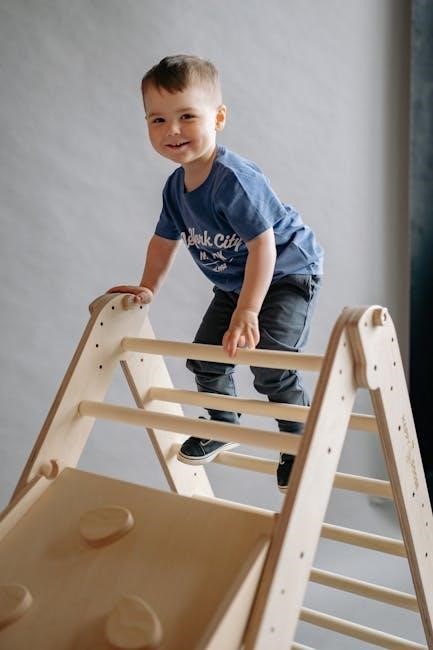
Fine Motor Skills Development
Fine motor skills development for 3-5 year olds involves activities like using small tools‚ playdough‚ and puzzles to enhance hand-eye coordination and dexterity in young children.
Using Small Tools and Objects
Using small tools and objects helps 3-5 year olds refine their fine motor skills through activities like tweezing marbles or manipulating playdough. These tasks enhance hand-eye coordination and dexterity‚ preparing children for tasks such as using scissors or buttons. Activities like pouring rice or sorting beads also improve precision and control. Providing access to tools like crayons‚ tongs‚ or small utensils fosters independence and creativity. Adult supervision ensures safety while encouraging mastery of these essential skills.
- Tweezers and marbles for pincer grip practice.
- Playdough with rollers and cutters for finger strength.
- Sorting games with beads or buttons for hand-eye coordination.
Playdough Creations
Playdough creations are an excellent way to enhance fine motor skills and creativity in 3-5 year olds. Children can mold‚ roll‚ and shape dough using tools like rollers and cutters‚ fostering hand-eye coordination and finger strength. This tactile activity encourages imagination and problem-solving while refining dexterity. Providing various textures and colors adds complexity‚ helping children explore and create. Adult guidance can introduce new techniques‚ while allowing freedom for self-expression. Playdough play is both educational and enjoyable‚ making it a valuable tool for physical and cognitive growth.
- Rolling and flattening dough to practice hand movements.
- Shaping objects to improve finger dexterity.
- Using tools like rollers for precision and control.
- Solving simple puzzles to enhance hand-eye coordination.
- Matching colors or shapes to improve recognition.
- Completing themed sets to boost memory and focus.
- Strengthens cardiovascular health.
- Improves flexibility and coordination.
- Supports healthy weight management.
- Enhances endurance and stamina.
- Enhances spatial awareness and coordination.
- Improves memory and concentration skills.
- Encourages creativity through active play.
- Supports problem-solving abilities.
- Encourages teamwork and cooperation in group games.
- Develops communication skills through verbal interactions.
- Enhances empathy and understanding of others’ feelings.
- Promotes sharing and taking turns during play.
- Tag and chase games improve running and agility.
- Obstacle courses develop problem-solving and movement skills.
- Riding bikes or scooters refines balance and coordination.
- Encourages children to practice speed and directional changes.
- Improves cardiovascular fitness through consistent movement.
- Enhances coordination and balance during fast-paced play.
- Supports social skills by encouraging cooperation and sharing.
- Crawling through tunnels improves flexibility and upper body strength.
- Jumping over small hurdles boosts leg power and agility.
- Balancing on beams or narrow surfaces refines equilibrium and focus.
- Combining multiple challenges encourages persistence and physical endurance.
- Balancing on a scooter or bike strengthens core muscles and stability.
- Pedaling or pushing with the legs enhances leg strength and endurance.
- Steering and navigating obstacles boosts spatial awareness and coordination.
- These activities also encourage outdoor exploration and active play.
- Dance parties encourage movement and rhythm.
- Balloon volleyball develops hand-eye coordination.
- Yoga enhances flexibility and balance skills.
- Enhances motor skills and coordination.
- Encourages social interaction and teamwork.
- Supports cognitive and emotional development.
- Fosters creativity and independence.
- Enhances problem-solving and imagination.
- Supports social and emotional growth.
- Check equipment for durability and safety.
- Supervise children during physical activities.
- Use soft materials for fall surfaces.
- Clear floors of clutter and tripping hazards.
- Use soft mats for areas where children may fall.
- Supervise active play to prevent collisions.
- Ensure furniture is stable and secured.
- Ensure playground equipment is safe and well-maintained.
- Supervise children at all times during outdoor activities.
- Provide protective gear for cycling or scootering.
- Teach children to stay within safe boundaries.
- Lesson plans for motor skill development.
- Activity cards for easy reference.
- Progress checklists to monitor improvements.
- Balance exercises to improve coordination.
- Group games to enhance teamwork and movement.
- Obstacle courses for gross motor skill development.
- Jumping exercises to improve coordination.
- Hopscotch activities for balance and footwork;
- Obstacle challenges to boost overall fitness.
- Track improvements in gross motor skills.
- Monitor fine motor tasks like drawing or cutting.
- Identify readiness for new activities.
Puzzles and Matching Games
Puzzles and matching games are excellent for refining fine motor skills and cognitive abilities in 3-5 year olds. These activities enhance problem-solving‚ memory‚ and hand-eye coordination. Simple puzzles with large pieces help develop dexterity‚ while matching games improve recognition and sorting skills. Using colorful‚ themed sets adds engagement‚ encouraging children to focus and complete tasks. Progressing to more complex puzzles as skills improve builds confidence and patience. These activities also foster independence and critical thinking‚ making them a valuable part of physical and cognitive development programs.
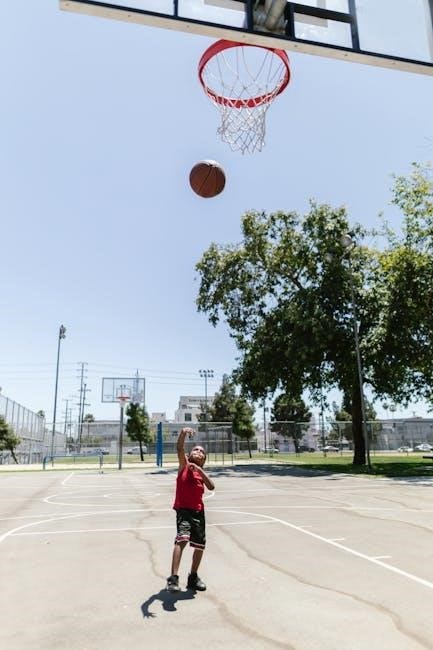
Importance of Physical Activity
Physical activity promotes health‚ strengthens muscles‚ and enhances heart function. It supports cognitive growth‚ improves coordination‚ and fosters social skills‚ ensuring overall well-being in 3-5 year olds.
Health Benefits
Regular physical activity for 3-5 year olds enhances heart function‚ strengthens muscles‚ and improves overall health. It boosts immunity‚ reduces obesity risks‚ and promotes better sleep quality. Active play also improves digestion and increases energy levels‚ fostering long-term well-being.
Cognitive Development
Physical activities for 3-5 year olds enhance memory‚ problem-solving‚ and concentration. Movement-based play improves spatial awareness and hand-eye coordination‚ fostering better academic performance. Activities like obstacle courses and balancing games encourage critical thinking and creativity‚ promoting overall brain development.
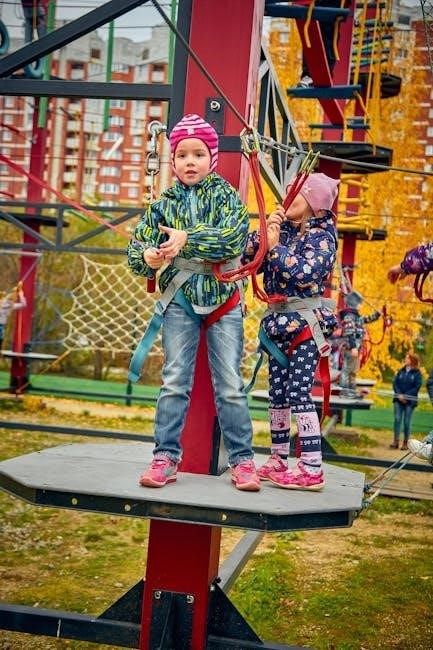
Social Skills Enhancement
Physical activities for 3-5 year olds foster social skills through teamwork‚ communication‚ and cooperation. Games like tag‚ chase‚ and group play encourage sharing‚ empathy‚ and conflict resolution. These interactions help children build friendships and understand social norms.
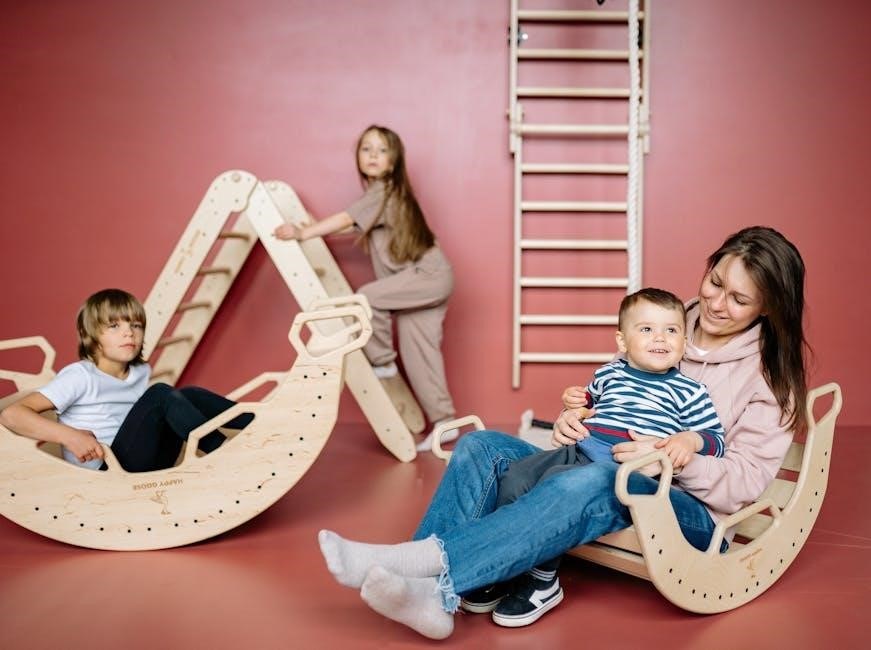
Outdoor Activities
Outdoor play supports physical development through activities like tag‚ chase‚ and obstacle courses. Riding bicycles and scooters enhances balance and coordination in 3-5 year olds.
Tag and Chase Games
Tag and chase games are excellent for enhancing physical development in 3-5 year olds. These activities promote running‚ agility‚ and endurance while fostering social interaction and teamwork.
These games are simple to organize and require minimal equipment‚ making them ideal for outdoor settings.
Obstacle Courses
Obstacle courses are engaging activities that promote gross motor skills in 3-5 year olds. These setups‚ often including crawling‚ jumping‚ and balancing‚ enhance coordination‚ strength‚ and problem-solving abilities.
Obstacle courses can be tailored to varying skill levels‚ ensuring inclusive and FUN physical development for young children.
Riding Bicycles and Scooters
Riding bicycles and scooters is an excellent way to enhance gross motor skills in 3-5 year olds. These activities improve balance‚ coordination‚ and overall physical fitness while fostering independence.
Supervision is key to ensure safety‚ making it a fun and developmental experience for young children.
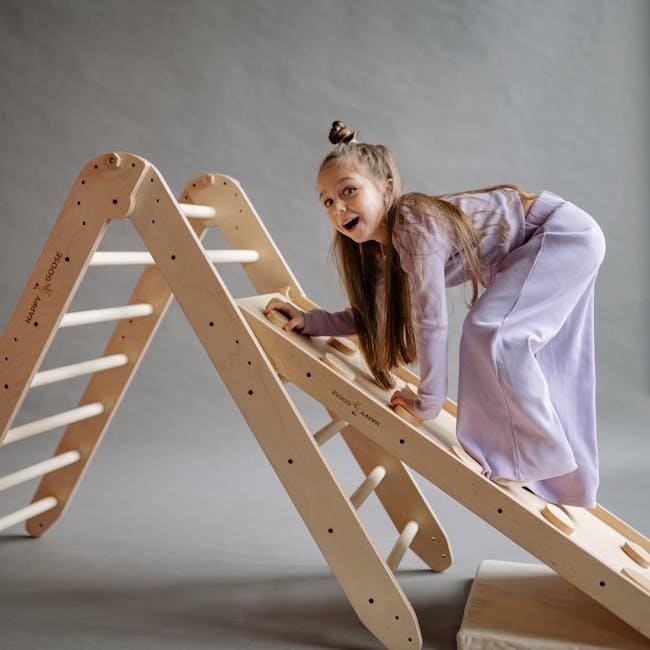
Indoor Activities
Indoor activities like dance parties‚ balloon volleyball‚ and kid-friendly yoga promote physical fitness and coordination in 3-5 year olds while ensuring safety and supervision.
These activities keep children active and engaged indoors‚ fostering fun and development.
Dance Parties
Dance parties are an engaging indoor activity that encourages movement and creativity in 3-5 year olds. Playing upbeat music and letting children dance freely fosters self-expression and joy‚ while also improving coordination and rhythm. Incorporating simple dance moves like clapping‚ jumping‚ and twirling can enhance gross motor skills. This activity also promotes social interaction‚ as children often dance together‚ imitate each other‚ or create group routines. Dance parties are a fun and dynamic way to keep young children active indoors while supporting their physical and emotional development.
Balloon Volleyball
Balloon volleyball is a fun and engaging indoor activity that promotes physical development in 3-5 year olds. Using a balloon and a makeshift net‚ children practice hitting the balloon back and forth. This game enhances hand-eye coordination‚ fine motor skills‚ and teamwork. It also encourages active movement‚ laughter‚ and social interaction. Balloon volleyball is an excellent way to keep children entertained indoors while improving their dexterity and coordination. The light‚ floating motion of the balloon makes it accessible for young children to develop their skills in a playful and non-competitive environment.
Kid-Friendly Yoga
Kid-friendly yoga is a fun and engaging activity that supports physical development in 3-5 year olds. Simple poses like “Tree‚” “Butterfly‚” and “Downward Dog” help improve balance‚ flexibility‚ and coordination. Yoga also enhances focus and concentration while promoting calmness and mindfulness. Using animal-themed poses makes it exciting for young children. This activity strengthens core muscles‚ boosts posture‚ and introduces the concept of body awareness. Regular practice can improve overall physical fitness while fostering a sense of accomplishment and self-confidence in young learners.
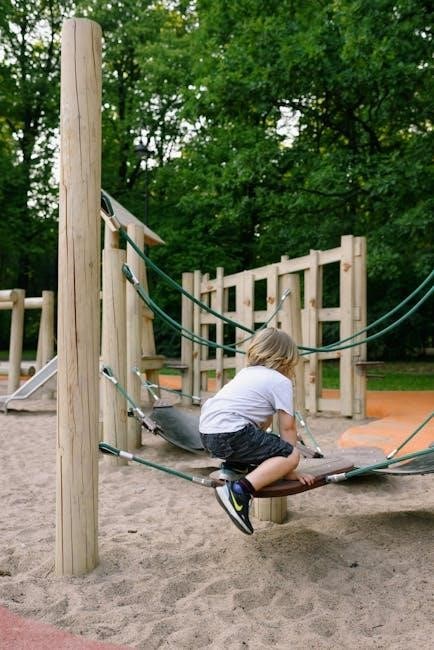
Structured vs. Unstructured Play
Structured play involves organized activities with clear goals‚ enhancing specific skills. Unstructured play allows creativity and exploration‚ fostering imagination and adaptability. Both support overall development in children.
Benefits of Structured Activities
Structured activities provide a focused environment for skill development‚ enhancing motor abilities through organized exercises like obstacle courses or dance sessions. They improve coordination‚ balance‚ and strength while fostering social interaction and teamwork. Such activities also promote cognitive growth by encouraging problem-solving and following instructions. Additionally‚ structured play helps build emotional resilience and confidence‚ as children achieve set goals and celebrate accomplishments. These activities are particularly beneficial for 3-5 year olds‚ as they lay a strong foundation for future physical and developmental milestones.
Encouraging Unstructured Play
Unstructured play allows children to explore and create their own activities‚ fostering creativity and independence. It promotes physical development through spontaneous movements like running‚ climbing‚ and jumping. Free play also enhances problem-solving skills and imagination‚ as children invent games and rules. Additionally‚ it encourages social interaction‚ helping kids learn to cooperate and resolve conflicts. Providing open-ended materials like balls‚ ropes‚ and outdoor spaces supports unstructured play‚ letting children naturally develop their gross motor skills and emotional intelligence at their own pace.

Safety Considerations
Ensure safe environments by checking equipment‚ supervising activities‚ and using soft landing surfaces. Teach children to follow rules and listen to instructions to prevent accidents during play.
Indoor Safety Tips
Ensure indoor spaces are safe for physical activities by removing breakable objects and securing furniture. Use soft mats or carpets to cushion falls. Supervise children during play to prevent accidents. Teach them to move carefully and avoid collisions. Store toys and materials in designated areas to reduce tripping hazards. Ensure proper lighting and ventilation for active play. Use age-appropriate equipment and materials that are durable and non-toxic; Encourage children to listen to instructions and stay within designated play zones for their safety.
Outdoor Safety Measures
Outdoor safety measures are crucial for physical development activities among 3-5 year olds. Ensure playground equipment is sturdy‚ free from hazards‚ and age-appropriate. Supervise children during outdoor play to prevent accidents and injuries. Dress them in weather-appropriate clothing and apply sunscreen. Provide protective gear like helmets for biking or scootering. Teach children to stay within designated play areas and avoid dangerous zones like roads or water bodies. Encourage hydration and regular breaks to prevent overheating. Inspect the environment for sharp objects or wildlife before play.

Resources and Tools
Resources like lesson plans‚ activity cards‚ and progress checklists support physical development in 3-5 year olds. These tools provide structured ideas and tracking for motor skills growth.
Lesson Plans
Lesson plans for physical development in 3-5 year olds are designed to promote gross motor skills through structured activities. These plans include exercises like balance poses‚ tag games‚ and obstacle courses‚ ensuring children develop coordination and strength. Available in PDF formats‚ they often feature step-by-step instructions and age-appropriate challenges. Many plans incorporate fun elements‚ such as music or storytelling‚ to engage young learners. Teachers and caregivers can use these resources to create engaging sessions that foster physical growth and active play‚ while also monitoring progress through built-in assessment tools.
Activity Cards
Activity cards provide engaging and easy-to-follow exercises for 3-5 year olds‚ focusing on physical development. These cards often feature step-by-step instructions and visuals‚ making them ideal for young learners. They include activities like jumping‚ hopping‚ and balancing to enhance gross motor skills. Designed for both indoor and outdoor use‚ activity cards are versatile tools for caregivers and educators. Many are available in downloadable PDF formats‚ offering convenience and accessibility for planning active play sessions tailored to children’s needs and developmental stages.
Progress Checklists
Progress checklists are essential tools for tracking children’s physical development in activities tailored for 3-5 year olds. These checklists help educators and parents monitor milestones like jumping‚ balancing‚ and using tools. Available in PDF formats‚ they often include specific skills to observe and goals to achieve. Regular updates ensure personalized support‚ allowing caregivers to identify areas for further development. By documenting progress‚ checklists provide clear insights into a child’s growth‚ ensuring they receive appropriate challenges and encouragement at each stage of their development journey.
